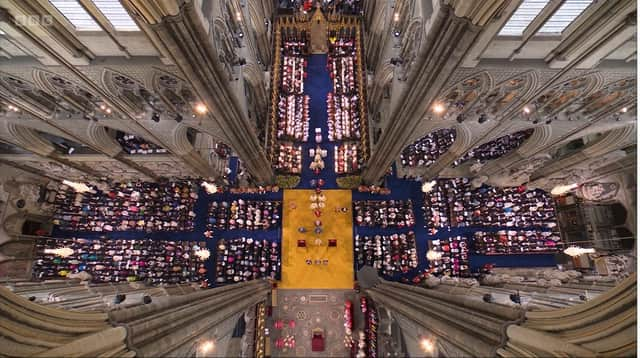Ben Lowry: My thoughts from Westminster Abbey on a glorious coronation service, that was cleverly made modern


(Scroll down for links to Ben Lowry writing about almost being late for the service and his other reports from London. Also his account of being in what he thought was a one-sided discussion on the Nolan Show this week)
The sun was shining for much of Friday, and is set to be present again today. I understand that almost 80,000 people have visited already, including 35,000 yesterday. The all time record of 120,000 visitors could yet be matched this year.
Advertisement
Hide AdAdvertisement
Hide AdIt was a pity that no royal visitor came to the show this week, or last year. For decades, including during the latter years of the Troubles, there was always a royal guest at Balmoral. It was a reflection of the immense importance of the event in a rural society such as Northern Ireland, and its showcasing of agriculture and food and business. But then I began to reflect on why there was no such visitor. Who would be free to attend? We were all led into a false sense of the feasible number of available working royals by the fact that the late Queen Elizabeth and Duke of Edinburgh carried on public duties decades past normal retirement age. A woman of the queen’s age, born 1926, would have retired at 60 in 1986 if she had even worked at all, which many of that generation did not. A man of Prince Philip’s age, born 1921, would also have retired in 1986 at the then normal retirement age for men of 65. Yet both Her Majesty and His Royal Highness kept up a punishing schedule of engagements for three decades beyond those norms.
For all that time, Prince Charles was available to attend events, as were his siblings Princess Anne, Prince Andrew and Prince Edward. Now Charles, himself far past retirement age at almost 75, as head of state has to free up his calendar to attend the most important fixtures. Prince Andrew had withdrawn from visits, while Prince Harry has quit as a royal. This leaves Anne, who was in Ulster only weeks ago, and Edward, here less than a year ago for the jubilee, and William and Kate, who have many bases to cover. We should get used to a slimmed down monarchy, and less appearances at events such as Balmoral. The king knows that a huge royal family could alienate the public.
The service on Saturday also reflected King Charles’s efforts to maintain the monarchy by adapting to modern sensibilities. There has been an astonishingly sudden and forceful political and cultural demand for diversity at all levels of UK society, and there was a careful attempt to reflect this demand in the coronation. It was not the sea of almost entirely white faces that would have packed the abbey in almost all major occasions of state since the building’s earliest parts were built 1,000 years ago.
I think I have never set foot in the abbey prior to last weekend, except perhaps a brief visit as a tourist. We journalists were seated in the north transept. That is the body of the church to the right of the image on this page. The sanctuary and altar are to the bottom of the intersection in the picture. The choir stalls are to the top and the main body of the abbey, where most guests were seated, is beyond that top section of the image. You can just about see where the media was seated in the glimpse of seats that are visible beyond two arches on the right hand side of the picture. We were facing the back of the choristers on the right of the stalls and looking at the stone wall behind them.
Advertisement
Hide AdAdvertisement
Hide AdDid that detract from the experience. Slightly, but it was truly remarkable to be there, regardless of the restricted view. If we craned our necks and looked to the left through those arches we could at points see the head of the king and other participants in the service as they moved around. We also had a screen in front of us showing the TV footage. But we had the joy of hearing the music being performed right around us. It was adapted to reflect a range of cultures, but never in a synthetic way (unlike churches which replace fine old hymns with drum kits and bad pop).
The web version of this article will link to my other writings on the occasion: how I was almost late for the service, how the Methody girl choristers were a highlight, my interviews with Ken Branagh and Michelle O’Neill afterwards. For here I would say that nowhere in the world does such events as well as Britain. The UK still has immense cultural influence, and its most important figures seem intent on adapting that culture to retain such influence. Many people will have disliked the connotations of the coronation and wanted to dislike its ceremony. But few people will been entirely immune to its extraordinary charms.
• Ben Lowry (@BenLowry2) is News Letter editor
• Ben Lowry on almost being late for the service
• Ben Lowry on his appearance on a one-sided BBC Nolan discussion
• Ben Lowry interviews Michelle O’Neill about the service